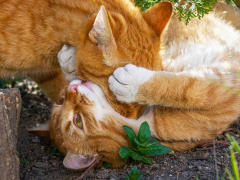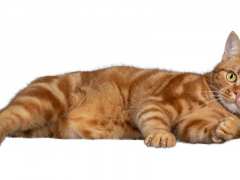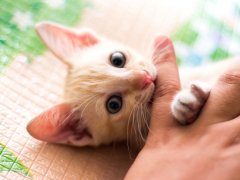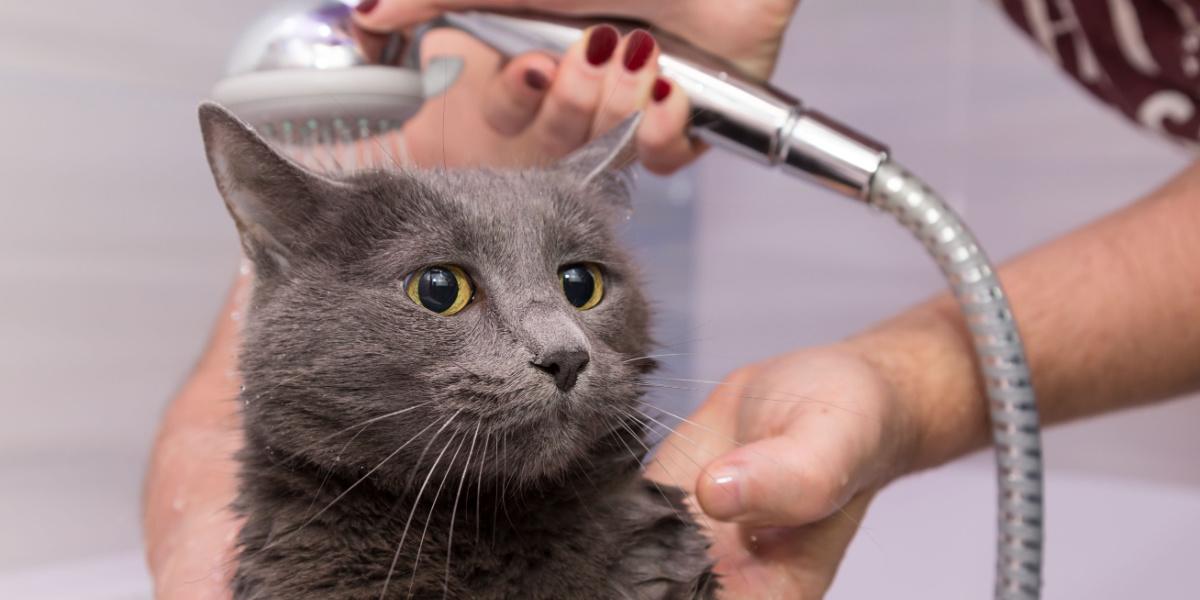
It’s common knowledge that most cats hate water. But why is this? It’s one of the most commonly-asked questions about cats, up there with “why do cats purr?” and “why do cats meow?”
Like purring, meowing, and the ability to sleep in positions that would leave us humans sore for weeks, the feline fear of water almost seems like a defining feature of their biological programming. But…why? Let’s dive a little deeper into this cat peculiarity and see what it is about water that makes the typical cat want to dash away and find a dry hiding spot.
Cats and Water – Like Oil and Water
Like so many questions about feline behavior, no one really knows why cats hate water.
The leading theories point to cats’ meticulous cleaning habits, their tendency to get cold after a dip, and their desert origins. But until we’re able to interview a cat about their aversion to water, these answers are just a few pieces of a complex puzzle.
Here are a few ideas about why cats—most of them, at least—are so scared of water.
1. Your Cat Descends From Desert Wildcats, Which Means That They Never Developed a Natural Interest in or Experience With Water.
A piece published by the Canadian Veterinary Medical Association suggests that cats’ ancestry may play a part in their aversion to water. Your cat’s wild ancestors evolved in arid climates where water was scarce and cats didn’t experience many lakes, rivers, streams, or even puddles.
Dr. John Bradshaw, professor at the University of Bristol’s School of Veterinary Science, told Mental Floss that cats “…never had to learn how to swim. There was no advantage to it.”
In other words, being in the water just wasn’t that useful to your cat’s ancestors, so it didn’t become a part of feline daily life. And for an animal as cautious as your cat, things that are unfamiliar usually look pretty scary.
On a side note, this desert history affects your cat’s relationship with water in another area—the water bowl.
The modern domestic cat’s low thirst drive is thought to be a remnant of their desert heritage and an environment that rewarded the ability to survive on high-moisture prey.
That disinclination to drink from a bowl means that cats seldom lap enough water to stay hydrated. That’s why it’s so important to give your cat a high-moisture diet rather than kibble.
And while his desert ancestors might have gone long stretches of time away from the watering hole, your cat should have a constant supply of fresh, clean water so he can drink whenever he wants to.
2. Your Cat’s Coat Gets Heavy and Uncomfortable When It’s Wet.
A cat’s coat is not that of a Chesapeake Bay Retriever. It’s neither oily nor waterproof nor easy to shake out. Taking a bath likely leaves your cat feeling clumsy and vulnerable.
Purina.co.uk suggests that it feels like “having to carry a soaking wet blanket on your shoulders until it gets dry again.”
And besides feeling like a soggy 10-pound blanket, a wet coat quickly reduces your cat’s body temperature. Especially if they live in cool climates or drafty houses, many cats will start shivering as soon as they get out of the bath.
3. A Water Bath Disrupts Your Cat’s Natural Grooming Routine
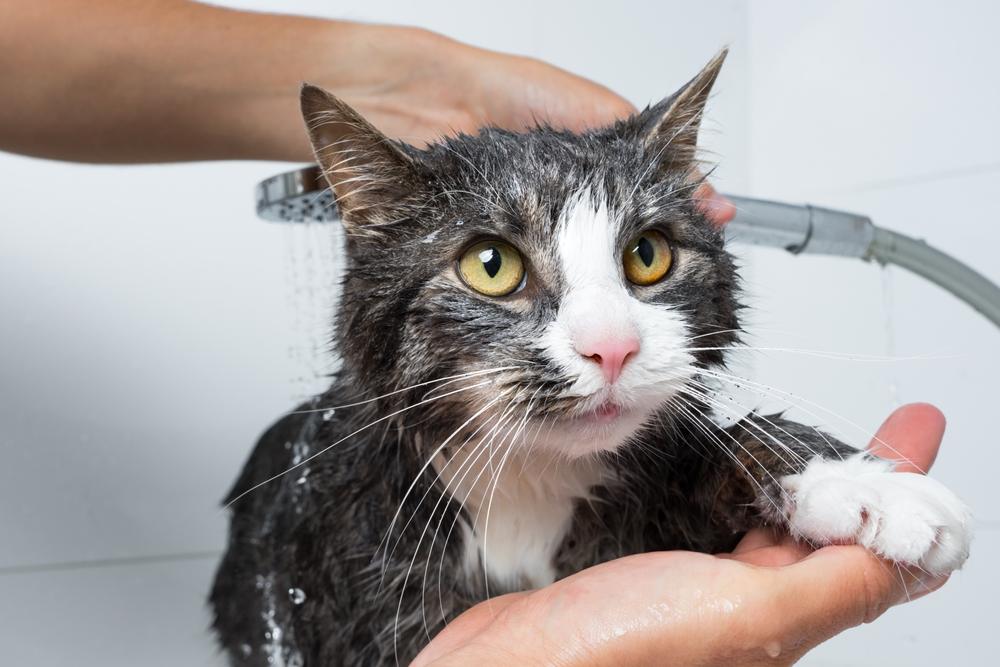
That water and shampoo can help to remove dirt and grease, but it also removes some of your cat’s natural scent.
Your cat likely spends hours of every day grooming themselves. Not only does all of that licking manage to keep your cat clean, but it also keeps their coat in order and keeps them smelling, well, like themselves.
When you put your cat in water, you muss his coat and remove some of that natural scent, replacing it with anything from the odor of tap water to an intense shampoo smell.
After getting out of the water, most cats immediately get to work on their own kind of bath, licking incessantly to restore their normal scent and getting every hair back in order.
But none of these reasons explain why your cat is so terrified when he encounters water.
While these explanations are interesting pieces of the puzzle, they don’t fully answer our main question. The underlying issue is that your cat is a highly sensitive creature and uncomfortable with just about anything that’s unfamiliar.
Also Read: The 10 Best Cat Slow Feeders & Puzzle Feeders
Everything about your cat is tightly-wound, ultra-aware, and ready to snap into action at any moment. Their eyes shift side-to-side. Their ears pivot. Their whiskers twitch. They’re watching for prey and listening for a chirp from across the house. They rarely drift into a deep sleep, lingering instead right on the edge of awakeness.
Whether resting, exploring, or staring at dust in a sunbeam, every part of your cat’s body is ready to react.
That hyper-awareness and sensitivity make cats respond to experiences differently than other animals. Compared to dogs, for example, they’re more likely to hide when guests visit, refuse to use a different type of litter, or stop eating due to stress.
So, yes. Your cat’s coat feels heavy when it’s wet. Water makes them cold. It removes their scent and has an odd smell of its own. And it’s not a deep-seated part of the historical feline experience.
But your cats’ intense sensitivity is why all of those factors—and perhaps others we haven’t identified yet—are so upsetting.
But…Not All Cats Hate Water!
Some cats are exceptions to the rule. Whether they like dipping a paw in the sink or going for a swim, a few rare cats enjoy being in and around water. Breeds with a particular affinity for water include Turkish Vans, Turkish Angoras, and Savannahs.
With no known physical difference between any of these breeds or individuals, personality is the biggest deciding factor in whether or not a cat will enjoy a dip into a little H2O.
Do Wild Cats Hate Water Too?
Not all of them!
Some big cats, like leopards, tigers, and jaguars, appear to enjoy getting drenched. The Fishing Cat takes this to extremes.
This smaller relative of the leopard lives along rivers, tidal creeks, and swamps and is known to swim underwater while pursuing their aquatic prey. Click here to watch an awesome video about the Fishing Cat.
Can You Train Your Cat To Like Water?
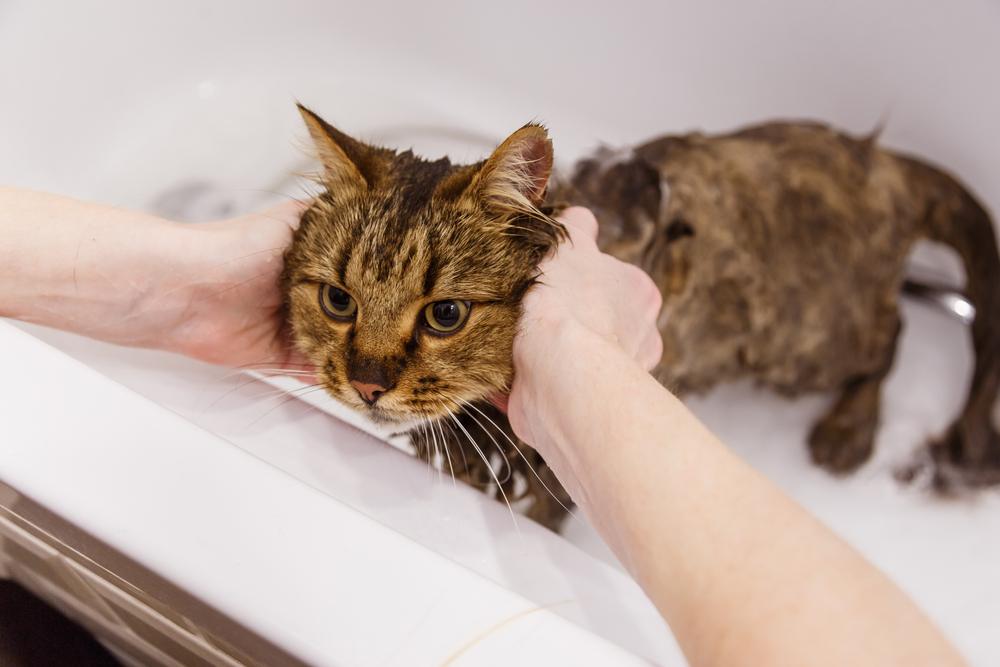
While kittenhood is the best time to establish a good relationship with water, taking the right steps can make bathtime less stressful for cats of all ages.
While there’s no way to guarantee that your cat will love baths and splashing in puddles, you can help them establish a relatively healthy relationship with water.
By introducing your kitten to water early in life, never forcing him to take a dip unless they’re ready, and playing species-appropriate games with water, you may be able to teach them that getting wet doesn’t have to be terrifying.
While kittenhood is the best time to establish a good relationship with water, taking the right steps can make bathtime less stressful for cats of all ages.
Only bathe your cat if there’s no better alternative—like if your cat is smeared with grease or has a flea infestation—and make it as comfortable as you can. If you’re looking for tips on how to safely give your cat a trauma-free bath, watch this video from Dr. Karen Becker.
Summing Up Cats and Water
Most cats, apart from the rare one, don’t enjoy going into the water. There are a few instances when a bath for your cat is necessary, such as if they are suffering from a flea infestation or their coat is covered in something oily like grease. You can help your cat learn to tolerate water under specific circumstances, though there is no guarantee that they will be totally on board with immersing themselves in water.
Be patient and gentle – bathtime does not need to be traumatizing. Remember that your cat can generally take care of their own hygiene naturally, and baths should only happen when there is no other alternative.
Want to learn more about why your cat does what he does? Explore more articles on cat behavior.

